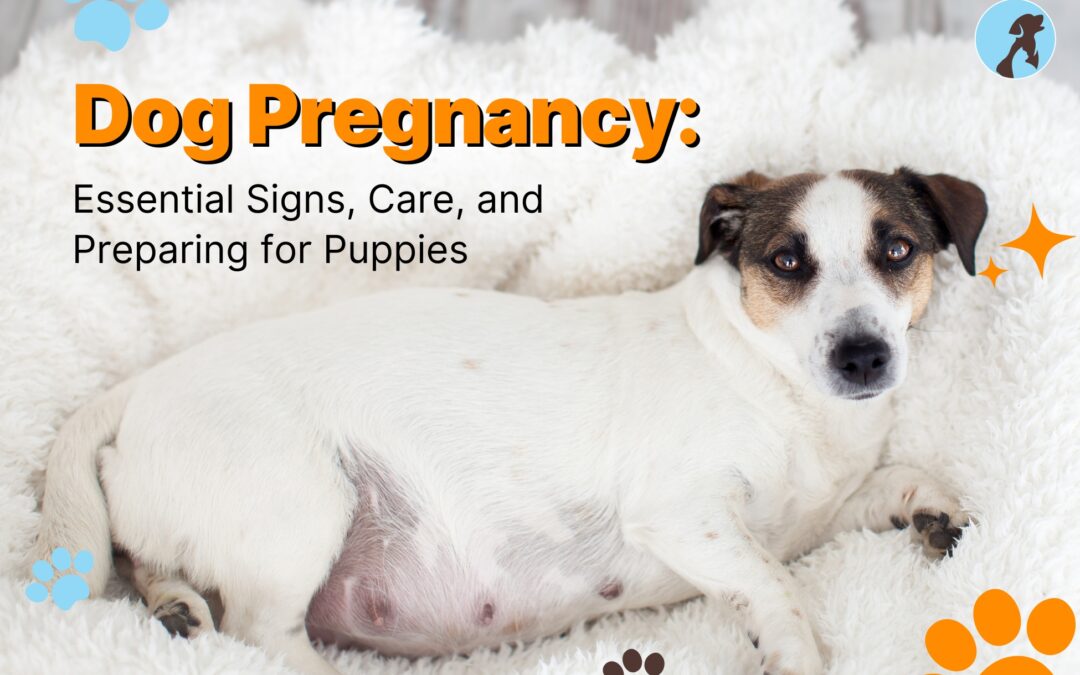Welcoming a new litter of puppies into the world is an exciting journey for any dog owner. Understanding the stages of dog pregnancy, from conception to labor, is crucial for ensuring the health and well-being of both the mother and her pups.
This comprehensive guide provides insights into the duration of dog pregnancy, signs of pregnancy, caring for a pregnant dog, essential supplies for whelping, and potential complications during labor.
How Long Are Dogs Pregnant?
The gestation period for dogs typically lasts between 58 to 68 days, with the average being around 63 days. However, this timeframe can vary depending on factors such as breed size and individual differences.
It’s essential to monitor your dog closely during this time and consult with a veterinarian for guidance and support.
How to Tell if Your Dog Is Pregnant?
-
- Changes in Behavior: Watch out for any unusual behavior in your dog, such as increased affection or nesting behavior.
- Changes in Appetite: Notice any changes in your dog’s eating habits, including increased or decreased appetite.
- Physical Appearance: Look for physical signs such as enlarged nipples or a swollen abdomen, although these may not be evident until later in the pregnancy.
- Consult a Veterinarian: If you suspect your dog is pregnant, consult with a veterinarian for confirmation. They can perform diagnostic tests like ultrasound or blood tests to confirm pregnancy accurately.
- Peace of Mind: Confirmation of pregnancy through veterinary diagnosis can provide clarity and peace of mind, allowing you to prepare appropriately for the upcoming litter.
5 Signs of Dog Pregnancy
-
- Weight Gain: Notice any gradual or sudden weight gain in your dog, which is a common sign of pregnancy.
- Enlarged Nipples: Check for changes in the size and color of your dog’s nipples, as they may become larger and darker as pregnancy progresses.
- Nesting Behavior: Observe if your dog begins to exhibit nesting behavior, such as gathering blankets or other materials to create a comfortable space for giving birth.
- Decrease in Energy Levels: Watch for a decrease in your dog’s energy levels or activity levels, as pregnant dogs may become more lethargic or tired.
- Preparation: Recognizing these signs can help you prepare for the impending arrival of puppies and ensure that your dog receives proper care and attention throughout her pregnancy.
6 Care Tips for a Pregnant Dog

Nutrition:
-
- Provide a balanced diet formulated for pregnant and nursing dogs to support her health and the development of her puppies.
- Consult with your veterinarian for dietary recommendations and potential supplements to ensure she receives adequate nutrition.
Veterinary Check-ups:
-
- Schedule regular veterinary check-ups throughout the pregnancy to monitor her progress and address any concerns promptly.
- Your veterinarian can provide guidance on prenatal care, vaccinations, and parasite control to safeguard her health and the health of her puppies.
Comfortable Environment:
-
- Create a comfortable and stress-free environment for your pregnant dog to promote a smooth pregnancy and delivery process.
- Provide a quiet, secluded area where she can rest and nest comfortably as she prepares for birth.
- Minimize environmental stressors and ensure she has access to clean water and adequate bedding for comfort.
Exercise and Activity:
-
- Encourage light to moderate exercise to help maintain her muscle tone and overall well-being.
- Avoid strenuous activities or excessive exertion that could pose risks to her and her developing puppies.
Monitoring and Observation:
-
- Monitor her closely for any signs of discomfort, illness, or complications throughout the pregnancy.
- Keep track of her weight gain, appetite, and behavior changes, and report any significant deviations to your veterinarian.
Preparation for Whelping:
-
- Educate yourself about the whelping process and familiarize yourself with signs of labor to be prepared for the birth.
- Assemble a whelping kit with essential supplies such as clean towels, heating pads, sterile gloves, and umbilical cord clamps.
- Develop a birth plan in consultation with your veterinarian and be prepared to provide assistance if necessary during labor.
Whelping Supply Checklist:
-
- Clean towels
- Heating pads
- Sterile gloves
- Umbilical cord clamps
- Digital thermometer
- Contact information for an emergency veterinarian
Possible Dog Labor Complications
While most dog pregnancies progress without complications, it’s essential to be aware of potential issues that may arise during labor. These can include prolonged labor, dystocia (difficult birth), or postpartum complications such as retained placentas or uterine infections.
Understanding the signs of labor complications and knowing when to seek veterinary assistance is crucial for ensuring the safety and well-being of both the mother and her puppies.
Conclusion
Navigating the journey of dog pregnancy requires knowledge, preparation, and attentive care. By familiarizing yourself with the stages of pregnancy, recognizing signs of impending labor, and having a well-equipped whelping kit on hand, you can help ensure a smooth and successful birthing experience for your beloved canine companion.
Remember to consult with your veterinarian for guidance and support throughout the process, and cherish the joyous arrival of your new furry family members.

